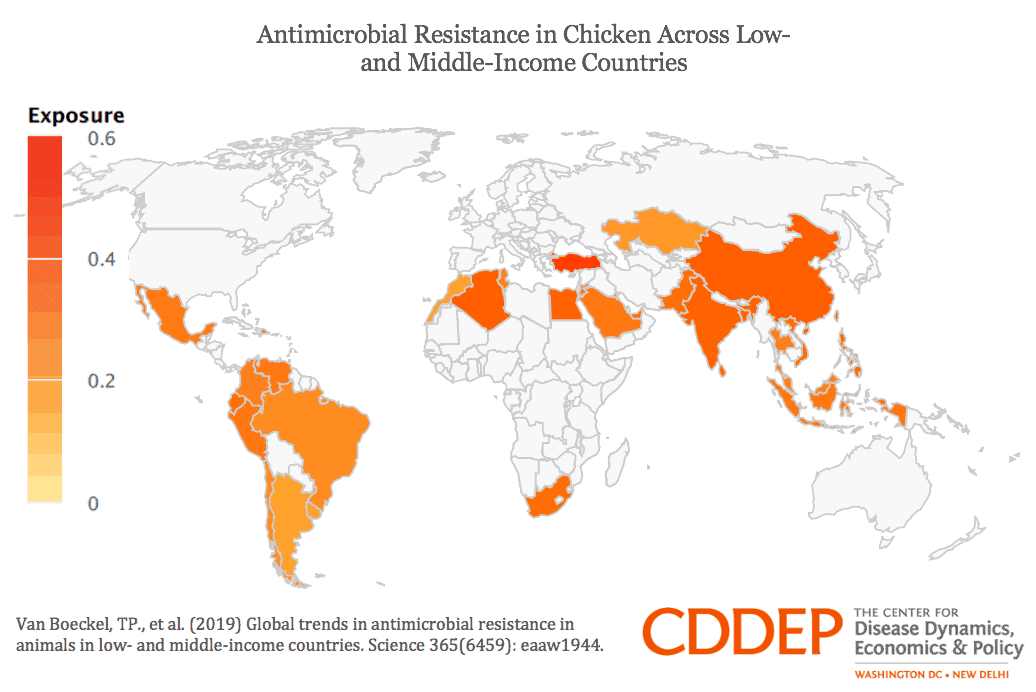March 13, 2020

COVID-19 pandemic continues to shock the world. The World Health Organization (WHO) officially declared the novel coronavirus outbreak a pandemic last week. Local transmission has become rampant outside China, and the world has been overwhelmed with panic, quarantines, and travel restrictions. Since December 2019, COVID-19 has spread across more than 115 countries worldwide. [WHO]
- In an opinion piece published in the Hindustan Times, CDDEP director Ramanan Laxminarayan discourages panic and urges the public to take action now in order to slow the further spread of the coronavirus before containment is out of reach. [HindustanTimes]
- In a study of 191 COVID-19 patients across two Wuhan hospitals, researchers found that older age, signs of sepsis, and blood clotting issues at hospital admission were linked to a higher risk of death. Hypertension, diabetes, and coronary heart disease were the most common comorbidities identified in patients, and viral shedding was observed in novel coronavirus survivors for up to 37 days, with a median duration of 20 days. [The Lancet]
DRC Ebola outbreak close to an end, WHO reports. The World Health Organization (WHO) announced that the Democratic Republic of Congo (DRC) has not reported any new cases of Ebola since February 17th, 2020, and the last confirmed Ebola patient was released from a treatment center on March 3rd, 2020. Although the outbreak that was declared in August 2018 is slowing down, the WHO recommends continuing outbreak control and waiting 42 days (the equivalent of two incubation periods) before officially declaring the end of the outbreak. [WHO]
Antimicrobial use and resistance common across animal production systems in Africa. In a review article of 176 studies published between 2005 and 2018, researchers found a high prevalence of antimicrobial use and resistance across animal production systems in Africa. Between 77.6 and 100 percent of farms across the African countries studied used antimicrobials in food-producing animals. The prevalence of multidrug-resistant Escherichia coli ranged from 20 to 100 percent in food animal samples, and from 33.3 to 100 percent in environmental samples. Tetracycline, aminoglycoside, and penicillin were the most commonly used antibiotic groups identified in the review. The study also found that none of the countries have implemented national surveillance programs that monitor antimicrobial use and resistance specifically in animals or the environment. [Antimicrobial Resistance and Infection Control]
Second patient cured of HIV through stem cell transplantation. A London patient has been cured of human immunodeficiency virus (HIV) after undergoing a stem cell transplantation, according to evidence published in The Lancet HIV. The patient’s HIV viral load has remained undetectable for 30 months after halting antiretroviral therapy, without detectable virus in the patient’s blood, cerebrospinal fluid, intestinal tissue, or lymphoid tissue. In 2011, one other patient was cured of HIV through stem cell transplantation, which is a risky procedure that should only be used as a last-resort treatment for certain patients. [The Lancet HIV]
Resistant foodborne pathogens common across Europe. The European Food Safety Authority (EFSA) and the European Center for Disease Prevention and Control (ECDC) released a summary report noting a rise in antibiotic resistance among certain foodborne pathogens across the European Union (EU). Data from 28 European countries between 2017 and 2018 revealed that 28 percent of Salmonella isolates taken from people were multidrug-resistant, along with 47.4 percent of isolates obtained from pig carcasses, 32.7 percent from broilers, and 22 percent from calves. The authors also note that reports of carbapenem-resistant foodborne bacteria in the EU are especially of concern. On the positive side, between 2015 and 2018, decreasing trends in Escherichia coli resistance to all antibiotics as well as the detection of extended-spectrum beta-lactamase (ESBL) or AmpC-producing E. coli among food animals were observed in six and twelve countries, respectively. [ECDC, CIDRAP]
One-third of hospitalized children receive antibiotics each day in the US. In a cross-sectional analysis of 51 children’s hospitals in the US between 2017 and 2018, researchers found that over one-third of patients less than 18 years old received an antibiotic on any given day; 12.5 percent of whom received a broad-spectrum antibiotic. The prevalence of antibiotic use across hospitals ranged from 22.3 to 51.9 percent and was as high as 58.3 percent in pediatric intensive care units. [Infection Control and Hospital Epidemiology]
Ebola vaccination tied to reduced severity and mortality of virus. A retrospective study in the Democratic Republic of Congo (DRC) found that Ebola vaccination with rVSV-ZEBOV was tied to reduced severity and mortality among patients infected with Ebola virus. The study found that vaccinated patients were admitted to the hospital sooner, had lower viral loads at hospital admission, and had lower odds of acute kidney injury at admission than unvaccinated patients (p<0.03). Mortality was significantly lower among vaccinated patients compared to unvaccinated patients, at 23 vs. 55 percent respectively (OR=0.24, p<0.001). [Vaccine]
Study results demonstrate efficacy of FDA-approved treatment for drug-resistant TB. A single-group study demonstrated the efficacy of a combination treatment (bedaquiline, pretomanid, and linezolid) for highly drug-resistant tuberculosis (TB) among patients in South Africa. Six months following treatment with the regimen, 90 percent of the 109 patients involved in the trial had a favorable outcome, although seven deaths, one relapse, and some manageable toxic effects occurred. These newly published results provided evidence for the US Food and Drug Administration (FDA) to approve pretomanid as part of the three-drug treatment for highly-resistant TB in August 2019. [NEJM]
Women in China express moderate intention to receive HPV vaccine. In an online survey of 2,339 adult women in China, nearly 60 percent reported intent to receive the human papillomavirus (HPV) vaccine. Being a young mother, living in an urban area, working managerial or professional jobs, knowing someone with cervical cancer, and being able to make independent decisions regarding HPV vaccination were all factors associated with intent to obtain the vaccine. The study also found that a majority of respondents were willing to pay for the bivalent, quadrivalent, and 9-valent vaccines (81.2, 75.9, and 67.7 percent respectively). [Vaccine]
AMR exposure is high among chickens in LMICs. In collaboration with Health Geography and Policy Group at ETH Zürich, CDDEP helped develop Resistance bank, an online repository for point prevalence surveys on antimicrobial resistance (AMR) in animals, with a focus on low and middle-income countries. It is aimed at providing the scientific community with a focal point to share information on AMR, and to help inform evidence-based policies by making global maps of AMR available to the public. Below are estimates of antimicrobial resistance exposure by country. [CDDEP, ResistanceMap]












